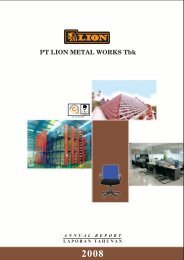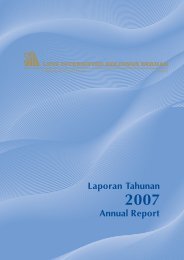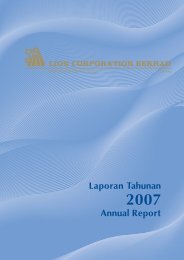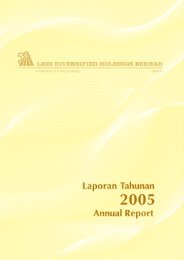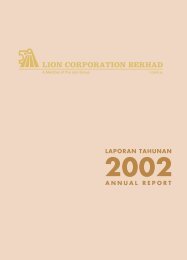continued - The Lion Group
continued - The Lion Group
continued - The Lion Group
You also want an ePaper? Increase the reach of your titles
YUMPU automatically turns print PDFs into web optimized ePapers that Google loves.
3. SIGNIFICANT ACCOUNTING POLICIES (<strong>continued</strong>)<br />
(n) Financial Instruments (<strong>continued</strong>)<br />
(iv) Payables<br />
Payables are stated at cost which is the fair value of the consideration to be paid in the future for<br />
goods and services received.<br />
(v) Interest Bearing Borrowings<br />
Borrowings are initially recognised based on the proceeds received, net of transaction costs incurred. In<br />
subsequent periods, borrowings are stated at amortised cost and any difference between net proceeds<br />
and redemption value is recognised in the income statement over the period of the borrowing using<br />
the effective yield method.<br />
Bonds and debts are stated at net present value plus accreted interest and net of amortised issuance<br />
expenses. <strong>The</strong> accretion of interest on the bonds or debts is recognised as interest expenses on the<br />
basis of their underlying cash yield-to-maturity.<br />
Borrowing costs incurred to finance the construction of property, plant and equipment are capitalised<br />
as part of the cost of the asset until the asset is ready for its intended use.<br />
All other borrowing costs are recognised as an expense in the income statement in the period they<br />
are incurred.<br />
(vi) Preference Shares (“PS”)<br />
PS are recorded at the amount of proceeds received, net of transaction costs.<br />
PS are classified as non-current liabilities in the balance sheet and the preferential dividends are<br />
recognised as finance costs in the income statement in the period they are incurred.<br />
(vii) Redeemable Convertible Secured Loan Stocks (“RCSLS”)<br />
<strong>The</strong> RCSLS are regarded as compound instruments, consisting of a liability component and an equity<br />
component. At the date of issue, the fair value of the liability component is estimated using the<br />
prevailing market interest rate for a similar non-convertible bond. <strong>The</strong> difference between the proceeds<br />
of issue of the convertible loan stocks and the fair value assigned to the liability component represents<br />
the conversion options included in equity. <strong>The</strong> liability component is subsequently stated at amortised<br />
cost using the effective interest rate method until extinguished on conversion or redemption, whilst<br />
the value of the equity component is not adjusted in subsequent periods. Attributable transaction<br />
costs are apportioned and deducted directly from the liability and equity component based on their<br />
carrying amounts at the date of issue.<br />
(viii) Derivative Financial Instruments<br />
Derivative financial instruments are not recognised in the financial statements.<br />
(ix) Equity Instruments<br />
Ordinary shares are classified as equity. Dividends on ordinary shares are recognised in equity in the<br />
period in which they are declared.<br />
<strong>The</strong> transaction costs of an equity transaction are accounted for as a deduction from equity, net of tax.<br />
Equity transaction costs comprise only those incremental external costs directly attributable to the<br />
equity transaction which would otherwise have been avoided.<br />
53



